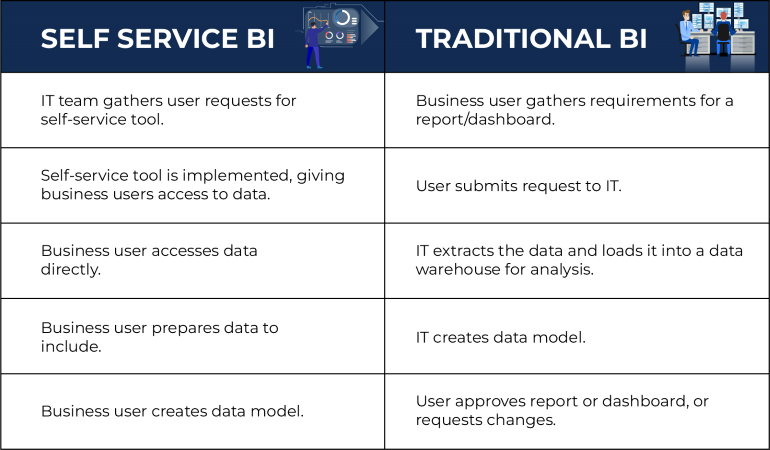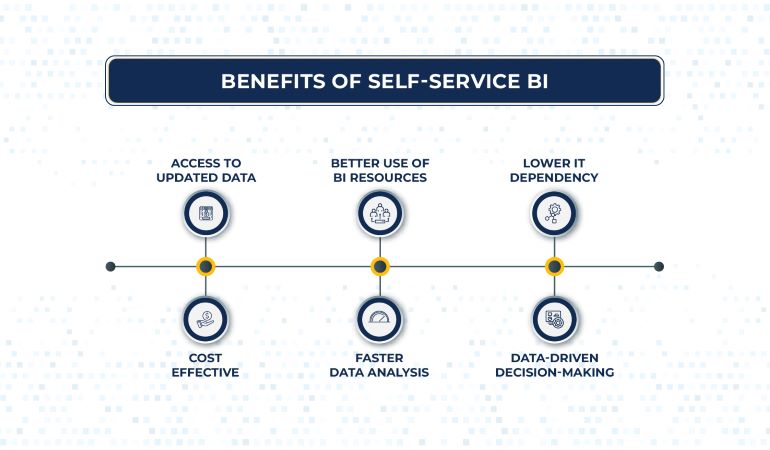Self-service business intelligence is a data analytics approach whereby individuals and teams access, analyze, and explore data without requiring help from IT specialists, statisticians, and other related fields. Therefore, you do not need a background knowledge of functions like data mining and analytics – the purpose of self-service BI (SSBI) is to enable you to do much of this without prior knowledge or outside help.
This article explains SSBI in BI and data analytics services, how it differs from traditional BI, and its advantages and limitations.
What is Self-Service BI?
Self-service business intelligence enables non-technical users to access, analyze, and visualize data. Managers and business analysts use self-service BI to take control of their data without relying on assistance from IT or data specialists.
What differentiates self service BI from traditional BI? The answer lies in who uses the tools.

Traditional business intelligence platforms and tools rely on the IT team or BI analysts to provide users with data analysis and insights. A BI analyst runs data queries for other users.
For example, a sales executive gathers customer and sales data and forwards it to the BI team for analytics and generating reports or dashboards. The BI team then queries the data to generate forecasts, performance reports, design dashboards, etc. This approach entails a high level of business teams’ dependency on the BI or IT teams for data insights, thus leading to resource limitations and causing delays in accessing critical insights.
Business intelligence is an iterative process that yields maximum benefits when relevant data is provided to business executives in a timely manner. Traditional BI causes delays.
On the other hand, self service BI tools aim to facilitate and empower end users by limiting their dependence on IT and data specialists. While BI teams are still involved in data mining and modeling, they are not burdened by random reporting requests from users. This enables them to focus on more demanding tasks.
However, self service business intelligence does not mean you train all your users to become data analysts, nor does it mean you’re clipping your IT team’s wings by limiting their scope of work. It only means enabling non-IT employees to actively understand how data is used and utilized across the company. It also means allowing more room for your IT teams to focus on data governance and ingestion in the organization while enabling data analysts to focus on mining and modeling.
Companies encourage self-service BI to enable their employees – including frontline workers and high-level executives – to access and utilize key business insights from the data present in their BI tools. The aim is to help the company improve its business outcomes, drive profitability, increase efficiency, and enhance customer satisfaction through data-driven decision-making at all levels.
What Makes a Platform Self Service BI?
Self-service business intelligence involves using one or more BI tools that enable data access to multiple teams in your enterprise. Which tool you should use depends on your company’s needs. Nevertheless, a is self service aim to use a BI platform that has the following features:
- Data Sources – Your SSBI tool should enable the effortless connection between users and multiple data sources (accessible from any device, anywhere). This allows your business teams to access relevant data whenever the need arises.
- Data Preparation – It is critical to prepare your data before analyzing it. This process entails identifying and removing outliers, treating missing values, joining tables, changing data types, etc. As an SSBI tool user, you need to determine how much scripting you need to prepare for the data analysis and whether you require advanced SQL knowledge to achieve it. An SSBI platform will help you quickly transform your data and enable faster analysis. It should also have data curation, modeling, sharing, and collaboration features.
- Ease of Reporting – In order to enable self-service BI, your platform should allow its users to easily build, edit, manipulate, and execute business logic to reports while utilizing advanced capabilities.
- User Interface – An easy-to-use, intuitive, and engaging interface is a critical component of good BI platforms. A successful SSBI offers an intuitive interface for its desktop and mobile applications. It also supports data sharing, collaboration, report sharing, and dashboards across both types of devices.
Other features to look for in your SSBI tool include the following:
- Tools that help create data visualizations for narrative presentations
- Geospatial and mapping data functionality
- Data catalog software and preparation tool
- Predictive modeling feature
- Easily deployable
- Aligns with your company’s existing data architecture
Benefits of Self Service BI
Self-service BI significantly expands your data analytical capabilities. Some of its major advantages include the following:

-
Access to Updated Data
SSBI tools give you a single version of truth by extracting data from various enterprise systems like CRM and ERP, etc., and bringing it together in one centralized location. Thus, it offers all users relevant, consistent, and up-to-date information.
You can perform data transformations, create engaging visualizations, and build powerful data models to help you derive critical business insights using SSBI tools. As a result, you can eliminate inefficient processes and replace them with streamlined ones, remove silos, improve efficiency, and foster transparency.
-
Better Use of BI Resources
Self service BI tools allow non-technical users to handle their own reporting and analysis needs. This reduces the reliance on IT teams for routine tasks such as creating custom reports. Allowing IT professionals and data specialists to focus on higher-value activities.
-
Lower IT Dependency
The best thing about SSBI is that it reduces the dependency of your business teams (Sales, Marketing, HR, Finance, etc.) on your BI and IT teams. When these other teams become capable of dealing with basic analytical needs on their own, they allow the BI and IT teams the time to focus on more complex matters like curating data sets, creating visualizations, dealing with complex queries, etc.
-
Cost Effective
Another significant benefit of using self-service BI is that it eliminates the need for you to invest in data infrastructure like data warehouses and licensing costs. Moreover, as more and more companies turn to BI for data utilization, SSBI tools will become more scalable, thus making room for more users without causing access problems.
-
Faster Data Analysis & Decision-Making
Self-servicing ability aids in eliminating bottlenecks in the Microsoft Power platform by moving the analytical tasks to other teams’ members instead of bogging down a handful of BI resources with them.
This helps in faster data analysis and quick decision-making as users analyze data and make relevant decisions.
-
Data-Driven Decision-Making
Another incredible benefit of self service business intelligence is its fostering a data-driven culture. As frontline workers and higher-ups alike learn self-service business intelligence through SSBI platforms, data-driven decision-making becomes the norm across the company. No longer do people have to follow their gut instincts—all they need to do is look at the data and decide accordingly!
Challenges of Self Service Business Intelligence
Despite all the benefits of self-service BI, companies often face significant challenges when deploying these tools.
These include the following:
-
Reluctance to Adopt
Resistance to change is a serious problem faced by trailblazers. Many employees, including C-suite executives and frontline workers, do not wish to embrace change. They would rather rely on their instincts for decision-making than learn self-service BI.
Such resistance seriously hampers a company’s SSBI initiatives. A poor BI tool interface can also be the reason for the lack of user adoption.
-
Inaccurate Results
Self service BI tools can often render inaccurate results owing to data errors or incomplete data sets. The risk of inaccurate results also increases when users work on various versions of the same data set or employ different methods to read a data set for analysis. Thus, such issues result in error-prone decision-making, making it difficult for users to trust the platform.
-
Security, Privacy & Ethical Issues
Since self-service BI expands data accessibility, it can lead to major data security issues if adequate data protection measures and data governance policies are not implemented. For instance, unauthorized access to sensitive data can increase, thus violating privacy regulations and ethical standards. It could also lead to the misuse of sensitive information.
-
Unrestricted Deployments
The role of Business Intelligence BI platforms can turn chaotic as opposed to beneficial if their deployment is not managed and overseen by an experienced BI team. Therefore, business teams should not be allowed to deploy these powerful tools independently. Instead, it should be managed by the BI team so that data silos and the use of multiple BI platforms don’t emerge.
You can overcome these challenges by formulating a well-laid-out SSBI strategy that helps you build a robust BI architecture. You also need to implement data governance and security standards so that violations do not occur. These steps will enable you to create an IT infrastructure supporting SSBI across the organization.
How to Choose a Self Service Tool?
Self service BI platforms have some main functions. To choose the right tool for your needs you need to go into details.
Here are the things you should look for in a self service BI tool:
-
Fast Implementation
The platform should be quick to implement and easy to maintain. The top self service BI platforms provide direct connections to data sources for fast implementation.
-
Affordability
The right tool should be affordable and provide value for money based on your organization’s needs.
Consider the tool’s pricing structure, including initial setup, licensing fees, and ongoing maintenance costs.
-
Easy to Use
A self service BI tool needs to be easy to use for both technical and non-technical users. Consider these factors to ensure ease of use:
- Users can easily connect to new data sources on their own, eliminating the need for technical support.
- Querying data is accessible to everyone, even those without SQL expertise. Users can construct queries through a graphical interface.
- Users can design and customize compelling visualizations and interactive dashboards with just a few clicks.
-
Dashboards
Dashboards are the crux of self-service business intelligence. Good dashboards have visualization variety and are easy to share.
-
Scalability
A good self service BI tool is an investment for the future. It grows alongside your business to meet the increasing demands.
Examples of Common Self Service BI Tools
Here are some popular self service BI tools widely used across industries:
- Microsoft Power BI
- Tableau
- Coefficient
- Qlik Sense
- Tibco
- Google Data Studio
- Looker
- IBM Cognos Analytics
- Sisense
Wrap Up
Even though switching to self service BI can seem challenging at first, it’s worth the effort. Organizations are increasingly turning to it to engender a culture of data-driven decision-making. There are far too many benefits of self-service business intelligence to ignore.
As data takes center stage in enterprise decision-making, exploring a BI tool that aligns with your company’s existing data architecture and long-term strategic goals will greatly help you, not to mention the competitive edge it will give you over your competitors!
If you need any assistance with self-service BI, contact us at [email protected].

